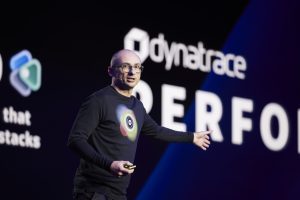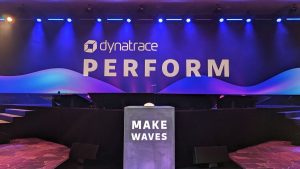Overseeing cloud spend and IT resource allocation has always been a priority for CIOs. Yet, in 2023, 82% of cloud decision makers reported that managing cloud spend was their top challenge, according to one source. In response, many organizations are adopting a FinOps strategy.
FinOps is an evolving cloud financial management discipline focused on enabling organizations to get maximum business value from their cloud spend. Following FinOps practices, engineering, finance, and business teams take responsibility for their cloud usage, making data-driven spending decisions in a scalable and sustainable manner. FinOps aligns technology initiatives with business objectives while maintaining financial transparency and accountability to reduce unnecessary cloud spend and lower costs.
Empowering teams to manage their FinOps practices, however, requires teams to have access to reliable multicloud monitoring and analysis data. In a Dynatrace Perform 2024 session, Kristof Renders, director of innovation services, discussed how a stronger FinOps strategy coupled with observability can make a significant difference in helping teams to keep spiraling infrastructure costs under control and manage cloud spending.
Primary reasons for runaway cloud costs
Organizations are paying too much for too little return on their cloud investments for a few reasons, including the following:
Cloud waste. The primary factor that most IT and business professionals are aware of—but may not completely grasp—is how to control cloud waste. Teams provision and purchase many cloud services that end up underused or completely unused.
Wrong-sized resources. Aligning workload types and sizes with instance performance and capacity requirements is essential to keep costs down.
Unnecessary data transfer. Cloud vendors often charge data egress fees when data shifts from their platforms or between regions. For example, Amazon Web Services (AWS) charges for data transfer between Amazon EC2 instances within the same region.
On-demand payment agreement. On-demand payment is the most expensive pricing option. Flexible pricing models that offer discounts based on commitment or availability can greatly reduce cloud waste. This includes spot instances such as unused cloud capacity that’s available at a discounted price.
Suboptimal architecture design. Poorly designed cloud solutions can become costly over time. For example, poorly written code can consume a lot of resources, or an application can make unnecessary calls to cloud services.
How to implement an observability approach to FinOps to lower costs
An observability approach to FinOps involves applying financial management principles to monitoring and analyzing cloud resources and spending. It provides visibility, accountability, and optimization opportunities within the context of observability practices in cloud computing environments. This enables organizations to effectively manage cloud spend and drive cost optimization to achieve maximum ROI.
The following five practices are crucial to consider when implementing an observability approach to FinOps.
1. Cost allocation
The first step is to determine who—or which application—is spending what. Assign an owner—whether it’s a financial owner, business unit, or cost center—to each application. You can then start pulling that information into the observability platform. When each team’s cost is visible, it’s possible to identify who, what, or where the issue is if costs unexpectedly skyrocket. This visibility allows an organization to allocate costs and look at unallocated costs to drive optimizations when and where needed.
Are there rogue servers running in the environment where ITOps, CloudOps, or another team can’t assign or identify who’s financially responsible for it? This awareness is important when the goal is to drive cost-conscious engineering.
2. Proactive cost alerting
Proactive cost alerting is the practice of implementing automated systems or processes to monitor financial data, identify potential issues or anomalies, ensure compliance, and alert relevant stakeholders before problems escalate. Setting up and monitoring alerts for various metrics—such as resource usage, cost trends, budget thresholds, or deviations from expected spending patterns—can help FinOps teams stay ahead of unexpected expenses or budget overruns.
This proactive alerting involves combining many technologies that already exist in the Dynatrace platform. An organization can ask Dynatrace, “Have you seen any oversized servers over X amount of time?” Dynatrace automated intelligence Davis CoPilot can see all dependencies and identify those servers. You can then use that ownership capability to find out who this server belongs to and notify that person.
Hyperscaler cloud service providers such as AWS, Microsoft Azure, and Google Cloud Platform can do this, too. They can send a notification saying, “This server is oversized.” But Dynatrace goes further.
Dynatrace looks inside the machine and immediately tells you what’s running on it. So, the person who then receives the ticket also knows what’s running on that server.
3. Resource utilization monitoring
A FinOps observability approach involves monitoring cloud resource utilization to identify inefficiencies and optimization opportunities. Observability tools can provide insights into resource utilization metrics, such as CPU usage, memory usage, and network throughput. By analyzing these metrics in conjunction with cost data, organizations can identify underutilized resources that can be downsized or terminated to reduce costs.
4. Forecasting and budgeting
A FinOps strategy involves forecasting future cloud costs and budgeting accordingly to align spending with business goals and objectives. Observability tools can provide historical cost data and usage trends, enabling organizations to accurately forecast future spending. By incorporating financial forecasting into observability practices, organizations can proactively manage costs and avoid budget overruns.
5. Carbon impact monitoring
Carbon impact monitoring tracks, measures, and analyzes the carbon emissions of an organization’s activities. This concept is closely related to environmental sustainability and corporate responsibility, as organizations seek to minimize their carbon footprints and mitigate their effects on climate change.
Carbon impact optimization is similar to optimizing from a financial perspective. The Dynatrace Carbon Impact app delivers recommendations to enforce and validate sustainable engineering, such as oversized servers running on your infrastructure, or a server used for an underutilized application. It ties that cost and carbon growth to your business, using the six pillars of a well-architected framework as a guideline.
Drive your FinOps strategy with Dynatrace
In the simplest sense, FinOps is about optimizing and using cloud resources more efficiently. It’s about ensuring the cloud and IT resources you have provisioned are used completely and that your applications, transactions, and processes are using only necessary cloud computing resources.
Dynatrace can help you achieve your FinOps strategy using observability best practices. With critical insights into how much you’re spending and whether your costs are aligned with your business goals, you can optimize your environment across all clouds and make informed decisions to reduce cloud spend and your IT carbon footprint.
To learn more, watch the Dynatrace Perform 2024 breakout session, “Driving your FinOps strategy with Dynatrace.”





Looking for answers?
Start a new discussion or ask for help in our Q&A forum.
Go to forum